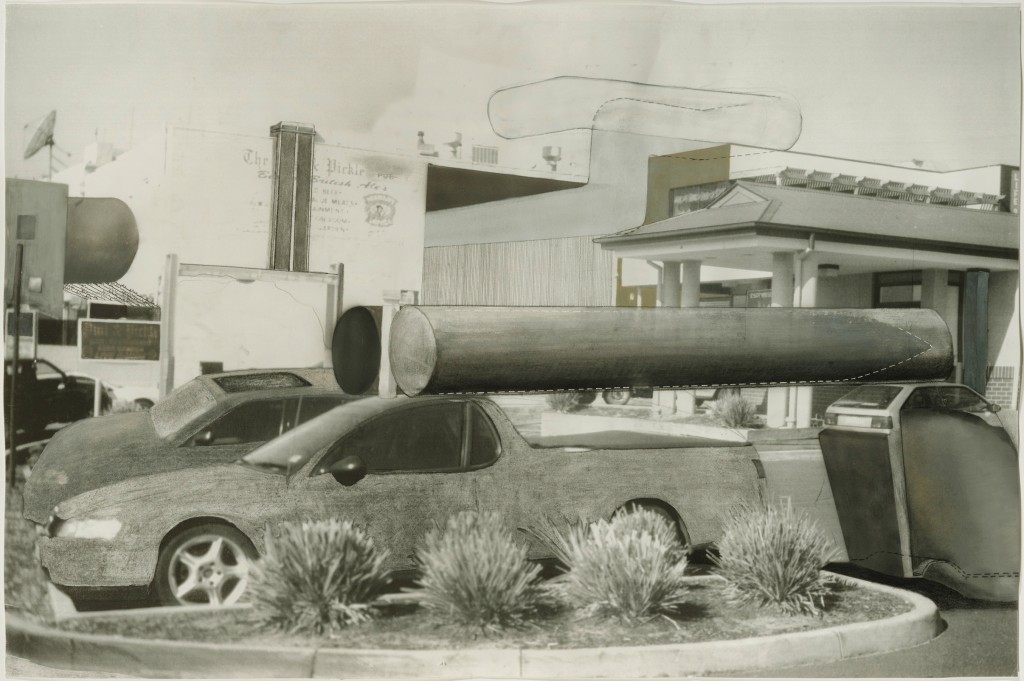
1 When did you start to make art?
In my mid teens I was doing life drawing a few years before I went to art school at a place in the outer suburbs. If I didn’t render space enough I lost interest. At a certain point I started drawing flying platforms for the life models with aircraft jets attached or too many fingers. It was sort of a conscious reaction to the surrounding engineered suburban roads and hills.
2 How did you evolve into a professional artist?
I was drawing very personal cartoons derived from The Waking Dream by Edward Lucie-Smith, and always wanting to have an exhibition, while also playing in bands. I first tried to keep a job drawing houses for sale in real estate sections of newspapers, and then inbetweening for Hanna Barbara, both jobs lasted a few months. I worked at lots of different jobs, and was a teacher once, but I gradually left any prospect of doing anything else but my own projects.
3 What drove you to make art as a professional vocation?
Almost all contemporary art I saw 25 years ago looked to me as if it was done by over curated professionals with very little or personal to say for themselves. I knew what would be better.
4 Explain your inspiration?
I think I love something before I make it.
5 In what way does your inspiration transform into ideas?
I recognise when it has happened.
6 From Ideas to production of art – how? And why?
I start with a good setup, e.g. a piece of paper on a hard surface at a bus stop, or a really good studio with all the equipment, and I finish with what I really wanted to do in the first place, and so there’s nothing more to do. Where I am at the time or what sort of studio I have can not be ignored, I tend to absorb unexpected things such as the lines of a particular make of car or whether infrastructure is crumbling or visa versa.
7 Could your ideas be portrayed in any other medium? If so which?
Yes even though ideas are developed through a medium.
8 Which artists would you most like to blatantly rip off?
Chris Burden, Alfred Kubin, Henry Chopin, L DaVinci, Wolf Huber because he fills in most of his blank spaces.
9 Why is your art made?
Its important for myself and others to at least have the illusion of going somewhere.

10 What does being an artists mean to you?
I imagine its not a designated work practice, and I change something which changes something else.
11 Are you happy with your reasons for making art? i.e Are there any trade offs that make life hard?
I’m not motivated to make life hard but if I was happy with my reasons I would be a different artist if at all.
12 When does your art become successful?
When there’s nothing left to do, it doesn’t need me, someone gets it.
13 What is art?
Visionary.
14 How do you start the process of making work?
I know its possible to get interested in anything, all you have to do is study something for 5 minutes as J Fusto in Dictionary for the Idle points out, but I don’t really stage direct how I start.
15 Who prices your work? And how is the price decided upon?
I am joined to the art market by my prices, or I forget about prices.
16 What is your next; move,project,show etc?
Arches and Seizures at Kaleid editions see:
alex-hamilton.com or www.kaleideditions.com
FLASH Review Redchurch Idler
Amending the 4th amendment
alters the constitution in one fell swoop,
leaving a junk document to provide
a halting lexical experience, viz
Arches & Seizures, a fragmentary
sous-texte that evokes dropped-off
shop signage on Main Street, set against
a background of swirling calligraphic
lines, a black & white banner to go
with the convulsive bop phrasings
of Alex Hamilton in ice trumpeter
video mode, his woolly-gloved jazz lampoon
of State pageantry and grandiloquence
also an autodestructive take on polar
meltdown, glottal buglings that
dissipate meaning, handiwork
inducing confusion & paralysis
in the flag-waving masses.
But now I’m interested in a war time attempt to make sea going barges out of concrete, and also moving country at least for a while, which will really have an effect.
17 What are the pros and cons of the art market?
Its like other markets, its needs don’t change, but I would prefer making a living through selling work than doing something which takes me away from my work.
18 Which pieces would you like to be remembered for?
There where good reasons why I stopped working on all my pieces, in which case any of them, probably a future piece.
19 Any routine in making your artwork? If so what?
Since the early eighties I’ve been drawing every day. Its been a long process of letting the unnecessary fall away, but that’s not a routine.
20 What has been the biggest break in your career?
Showing in prominent places.
21 Who has been the biggest influence on you?
Influenced by and ripping off.
America, the engraver Bresdin because he used too many lines…some of the people in L Lipards book Six Years who said things like “does one object imply the existence of another?, the hunting of the snark and a photographers day out, the poems of Malcolm Lowry, Auden, Lewis Hyde, a lot of Atlas press.
22 How many artworks have you given away and to whom?
Its only after a work is finished I can finally decide whether it is definitive an can go on for ever without me, or just ongoing. Like almost everyone I’ve given and exchanged a lot of material . I’m not sure if I give more in art than I get back. I’ve never received too much money for a work.



